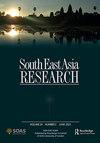Strategic hedging: a case study of nineteenth-century Siam
IF 0.9
3区 社会学
0 ASIAN STUDIES
引用次数: 0
Abstract
ABSTRACT A longstanding view in realist studies of international relations has been that within the context of great power competition, lesser states must choose between balancing or bandwagoning. However, a third option is also available: strategic hedging, which provides a means of explaining foreign policy strategies that do not traditionally fit within this standard binary. This article seeks to explain the Kingdom of Siam’s (modern-day Thailand) foreign policy during the nineteenth century when growing competition between European powers, namely France and Britain, manifested itself in aggressive and competitive intervention into South East Asia. Siam presents a unique case study, as it is one of only two states in Asia to resist direct colonization during that period. This article explores how, through a flexible foreign policy of strategic hedging in which complementary and mutually counteracting actions were undertaken within a wider context of great power competition, Siam maintained independence as a sovereign state.战略对冲:19世纪暹罗的案例研究
在国际关系的现实主义研究中,一个长期存在的观点是,在大国竞争的背景下,较小的国家必须在平衡或随波逐流之间做出选择。然而,第三种选择也是可用的:战略对冲,它提供了一种解释传统上不适合这种标准二元策略的外交政策战略的手段。本文试图解释19世纪暹罗王国(今天的泰国)的外交政策,当时欧洲列强(即法国和英国)之间的竞争日益激烈,表现为对东南亚的侵略性和竞争性干预。暹罗提供了一个独特的案例研究,因为它是亚洲仅有的两个在那个时期抵制直接殖民的国家之一。本文探讨了暹罗如何通过灵活的战略对冲外交政策,在更广泛的大国竞争背景下采取互补和相互抵消的行动,保持作为一个主权国家的独立性。
本文章由计算机程序翻译,如有差异,请以英文原文为准。
求助全文
约1分钟内获得全文
求助全文
来源期刊

South East Asia Research
ASIAN STUDIES-
CiteScore
1.90
自引率
0.00%
发文量
42
期刊介绍:
Published three times per year by IP Publishing on behalf of SOAS (increasing to quarterly in 2010), South East Asia Research includes papers on all aspects of South East Asia within the disciplines of archaeology, art history, economics, geography, history, language and literature, law, music, political science, social anthropology and religious studies. Papers are based on original research or field work.
 求助内容:
求助内容: 应助结果提醒方式:
应助结果提醒方式:


